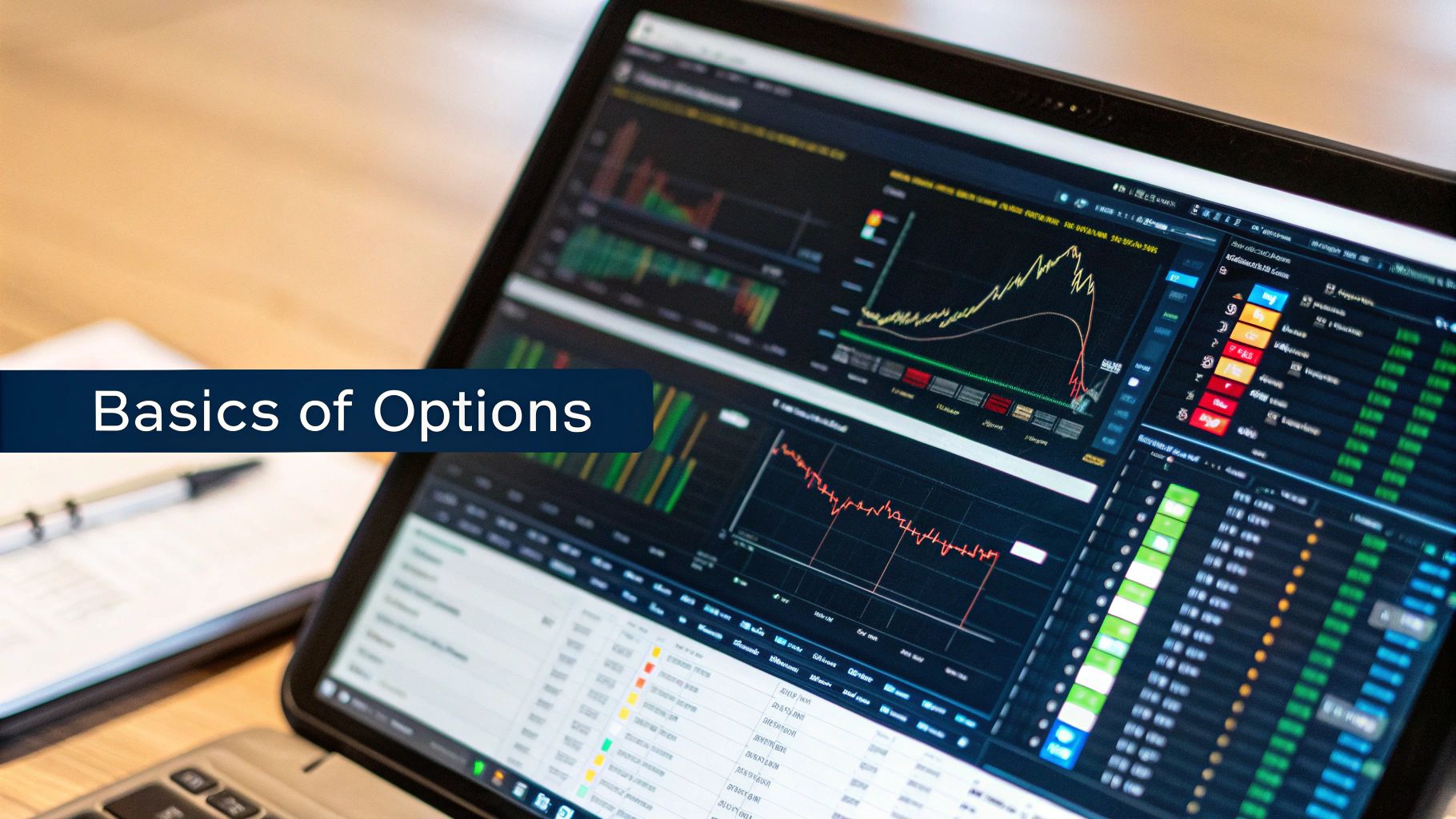Breaking Down the Options Trading Landscape

At its core, options trading gives investors a way to profit from price movements without buying stocks directly. When you trade options, you get contracts that give you the right – but not the obligation – to buy or sell a stock at a set price before a specific date. This creates more flexibility than regular stock trading. Let's say you think a $50 stock will hit $60 next month. Instead of buying the stock outright, you could buy a call option with a $55 strike price, letting you buy shares at $55 even if the price goes higher.
Understanding the Core Concepts of Options Trading
One of the main benefits of options trading is how it lets you make money in different market conditions while limiting risk. When you buy an option, you can only lose the amount you paid for it – the premium. For example, if you paid $2 per share for that $55 call option (covering 100 shares), your maximum loss would be $200, no matter how low the stock price drops.
The two basic types of options are calls and puts. Call options let you buy the stock, while put options let you sell it. This means buying calls is betting the price will go up, while buying puts is betting it will go down. Understanding these fundamentals is key before diving into more complex strategies.
Options Trading Strategies and Market Behavior
Beyond basic calls and puts, options trading opens up many strategic possibilities. You can use simple covered calls to earn income from stocks you own, or try advanced strategies like straddles that profit from big price swings in either direction. Rather than just betting on stocks going up or down, options give you tools to make money in any market environment.
Success in options trading requires understanding how markets actually behave. Looking at historical data from the Cboe Options Exchange, we see that most traders close out their positions before expiration – over 70% of contracts are closed early, about 20% expire worthless, and only 5% are exercised. This shows that active management matters more than buy-and-hold. Traders need to watch the markets closely and adjust their positions based on new information and changing conditions.
Mastering the Art of Calls and Puts
Once you grasp the basic differences between calls and puts, you can start exploring how traders actually use these options in real markets. Let's move beyond definitions and look at practical examples of how to apply these tools based on careful market analysis.
Calls: Betting on the Upside
A call option gives you the right to buy a stock at a set price (strike price) before the option expires. Think of it like a coupon that lets you buy something at last month's price, even if the actual price has gone up. When a stock rises above your strike price, that call option becomes valuable since you can buy shares at a discount. For example, say you think Company XYZ at $48 will hit $55 next month – you might buy a $50 strike call. If you're right and it reaches $55, you can buy at $50 and make $5 per share (minus what you paid for the option). This makes calls perfect when you expect prices to rise.
Puts: Profiting From Price Declines
Put options work the opposite way – they give you the right to sell at a set price. This acts like insurance against falling prices. The put gains value when the stock drops below your strike price since you can still sell at the higher price. For instance, if Company ABC trades at $100 but you think it's heading to $90, a $95 strike put lets you sell at $95 even if the market price is lower. This protects you from losses or can generate profits in a falling market.
Combining Calls and Puts: Strategic Applications
Smart traders often use calls and puts together in different combinations. These more complex strategies help manage risk and create opportunities in various market conditions. One common approach is the straddle – buying both a call and put with the same strike price and expiration. This pays off if the stock makes a big move either up or down. The key is that the stock needs to move enough to cover what you spent on both options.
Factors Influencing the Decision Between Calls and Puts
Picking between calls and puts requires more than just guessing market direction. Good traders analyze company financials, watch for important news, and study overall market trends. They use price charts and technical indicators to spot potential moves. They also pay attention to option-specific measures called "the Greeks" that show different types of risk. Success comes from carefully weighing all these factors before making trades.
The Greeks: Essential Metrics for Options Risk Management

While understanding basic options concepts like calls and puts is important, successful options trading requires mastering "The Greeks" – the key risk metrics that help traders evaluate and manage their positions. These essential measurements work together to provide a clear picture of how options respond to various market factors. Let's break down each Greek and see how they work in practice.
Understanding Delta: Measuring Price Sensitivity
Delta shows how much an option's price will change when the underlying asset's price moves by $1. It ranges from -1 to 1 as a decimal value. For instance, if a call option has a delta of 0.50, its price will go up by $0.50 when the stock price increases by $1. On the flip side, a put option with -0.30 delta will drop $0.30 in price for each $1 increase in the stock. This direct relationship helps traders estimate potential gains and losses as market prices shift.
Gamma: Understanding the Rate of Delta Change
Gamma measures how fast Delta changes as the underlying price moves. A high Gamma means Delta will change more dramatically with each $1 move in the asset price. For example, an option with high Gamma might see its Delta jump from 0.50 to 0.65 with just a small price change, while a low Gamma option's Delta might barely budge. This becomes especially important during big market swings when prices move rapidly.
Theta: Time Decay and Its Impact on Options
Theta represents how much value an option loses each day as it approaches expiration. Since all options expire eventually, this daily erosion of value is inevitable. For example, an option with -0.05 Theta loses $5 in value each day, assuming all other factors stay the same. This steady decline makes Theta a key consideration, particularly for traders holding options near expiration.
Vega: Measuring Volatility's Influence
Vega shows how sensitive an option's price is to changes in market volatility. When expected market volatility goes up, option prices typically rise since there's more potential for big price moves. Vega tells us exactly how much – for instance, a Vega of 0.15 means the option price will change by $0.15 for every 1% shift in volatility. This makes Vega especially useful during uncertain market conditions.
Rho: Interest Rate Sensitivity and Options
Rho indicates how interest rate changes affect option prices. While usually less significant than other Greeks, Rho matters more for long-term options. Generally, higher rates push call prices up and put prices down. For example, a call option with Rho of 0.05 gains $0.05 in value when interest rates rise by 1%. This becomes relevant for traders holding options for several months or longer.
By actively monitoring these Greeks, traders can better understand their risk exposure and make more confident trading decisions. Each Greek provides unique insights that, when combined, create a complete picture of an option's behavior under different market conditions.
Building Your Options Strategy Arsenal

Now that we've covered the basics of calls, puts, and the Greeks, let's explore how these fundamental building blocks come together to create effective trading strategies. Success in options trading isn't just about predicting market direction – it's about choosing approaches that match current conditions and your personal risk comfort level.
Understanding Options Spreads: Expanding Your Toolkit
Options spreads give traders more control by combining multiple contracts on the same underlying asset with different strikes or expiration dates. This creates strategies where both risk and potential profit are clearly defined upfront. Take the bull call spread as an example: you buy one call option at a lower strike price while selling another at a higher strike. If the asset price rises, you profit from the spread between the strikes, minus what you paid to open the position. The strategy caps both your maximum gain and loss.
Straddles and Strangles: Profiting From Volatility
When you expect big price swings but aren't sure which direction the market will move, straddles and strangles can help. A straddle involves buying both a call and put at the same strike price and expiration date. You make money if the price moves enough in either direction to offset the cost of both options. A strangle uses different strike prices – typically buying an out-of-the-money call and put. This costs less upfront but needs a larger price move to become profitable. For instance, with a stock at $50, you might buy a $45 put and $55 call, betting on a major move beyond that range.
Advanced Combinations: Creating Custom Positions
As you gain experience, you can explore more sophisticated strategies like butterfly spreads and iron condors. These combine four or more options to create specific profit zones with built-in risk limits. An iron condor, for example, involves selling both a put spread and call spread with the same expiration. You profit when the underlying asset stays within your chosen price range, though your maximum gain is limited to the premium you collect.
Practical Guidelines for Strategy Selection
Picking the right strategy depends on several practical factors. First, consider current market conditions – high volatility might suggest straddles, while steady trends could favor directional spreads. Next, be honest about your risk tolerance. Some approaches like naked call selling have unlimited risk, while others like covered calls have clear maximum losses. Most importantly, match strategies to your skill level. Start with straightforward positions and gradually test more complex ones as you build confidence through practice. Remember that consistent profits come from smart risk management, not swinging for home runs on every trade.
Creating Your Risk Management Framework
A solid risk management framework is essential for success in options trading, much like a sturdy foundation is crucial for a house. While you can't completely avoid risk in trading, you can learn to understand it, measure it, and protect against major losses. Think of it like wearing a seatbelt – you're not trying to prevent all accidents, but rather minimize potential damage when they occur.
Position Sizing: The Foundation of Risk Control
The first key rule of risk control is careful position sizing. This simply means deciding how much money you'll put into each trade. Many experienced traders follow the 1% rule – never risking more than 1% of their total account on a single position. For instance, with a $10,000 account, you'd limit your potential loss on any trade to $100. This straightforward approach prevents one bad trade from wiping out your account. By keeping position sizes modest, you can weather losing streaks and stay in the game long enough to develop your skills.
Stop-Loss Orders: Your Automated Safety Net
Stop-loss orders work like a safety switch that automatically closes your position if losses reach a certain point. For example, say you buy a call option on a $50 stock and set a stop-loss at $45. If the stock drops to that level, your position closes automatically – no emotional decisions required. While stop-losses can't prevent all losses, they act as guardrails to keep you from driving off a cliff during market turbulence. The key is setting them at levels that give your trades room to work while still protecting your capital.
Portfolio Balance: Diversification for Options Traders
Just as you wouldn't put all your eggs in one basket, spreading your options trades across different stocks and sectors helps reduce risk. You might trade options on tech stocks, consumer goods, and healthcare companies while using various strategies like covered calls and puts. This variety means that a drop in one area won't sink your whole portfolio. Even skilled traders make wrong calls sometimes – diversification helps soften the impact when they do.
Managing Emotions: The Human Factor
The biggest challenge in options trading often isn't market analysis – it's controlling your own reactions. Fear can make you exit winning trades too early, while greed might tempt you to risk too much chasing losses. Keeping a trading journal helps track both your decisions and emotions, showing patterns you can learn from. Write down not just what you traded, but why you traded it and how you felt. This self-awareness, combined with strict risk management rules, helps you stay objective when markets get choppy. Remember: consistent profits come from consistent processes, not emotional trading.
Reading the Market's Hidden Signals

Once you've built a foundation in options strategies and risk management, the next challenge is learning to read the subtle signals the market provides. While many traders focus on single indicators, the most successful ones know how to piece together multiple data points to form a complete picture. Let's explore how to decode these market signals effectively.
Interpreting Market Sentiment Through Options Data
The options chain offers rich insights into market sentiment. Think of it as a real-time snapshot showing all available options contracts for a stock. By studying the volume and open interest at different strike prices, you can see where other traders are placing their bets. For instance, if you notice an unusual spike in call option volume at $50, it suggests many traders expect the stock to rise above that price. While this doesn't guarantee the move will happen, it shows you what other market participants are thinking. The put/call ratio is another useful tool – it compares put option volume to call option volume, helping you gauge whether the overall market mood is optimistic or cautious.
Volatility as a Trading Signal: More Than Just Risk
Most traders see volatility only as risk, but it's also a valuable signal for potential price moves. When the VIX shows increased market volatility, big price swings often follow. Smart options traders don't try to predict which direction prices will move – instead, they adapt their strategy to match market conditions. During high volatility, they might use straddles or strangles to profit from large price moves in either direction. When markets are calm, they often switch to income-generating strategies like covered calls that work best when prices move sideways.
Combining Indicators for Actionable Insights
The best trading decisions usually come from combining multiple indicators into a clear signal. You might notice high call volume at a certain strike price right as the stock breaks through a major resistance level on the price chart. When multiple indicators line up like this, they often point to stronger trading opportunities. But remember – no single indicator is perfect. By looking at several different signals, you can better spot genuine opportunities and avoid false alarms.
Adapting to Changing Market Conditions
Markets never stand still, and successful options traders know they need to stay flexible. This means keeping up with market news, economic reports, and shifts in trader sentiment. Say you spot what looks like a strong upward trend using several indicators, but then see a sudden jump in put option volume. That might be your cue to review your position or adjust your risk management plan. Being ready to adapt your approach as markets change is key to long-term success with options trading.
Ready to simplify your covered call and cash-secured put strategy? Coverd turns hours of manual research into actionable insights in seconds, helping you boost portfolio returns and manage risk effectively. Learn more at https://coverd.io.

Leave a Reply